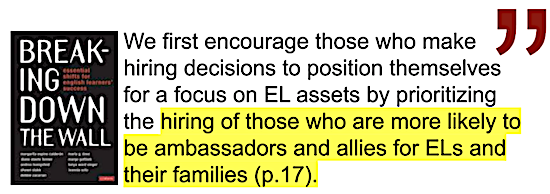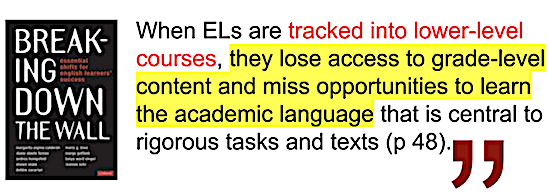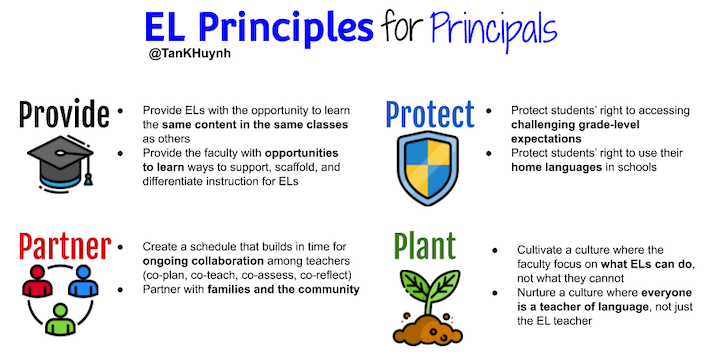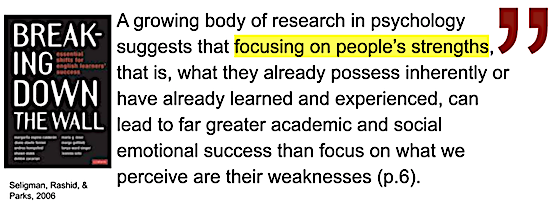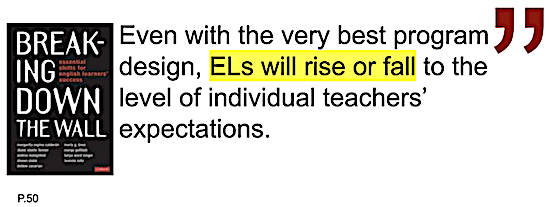English Learners: Four Principles for Principals
A MiddleWeb Blog
 Much of my work is at the grassroots level to empower teachers who work with children like I was. This is life-giving work, yet I am haunted by comments made repeatedly by teachers all around the world about how some policies and procedures at their schools inhibit their work with language learners.
Much of my work is at the grassroots level to empower teachers who work with children like I was. This is life-giving work, yet I am haunted by comments made repeatedly by teachers all around the world about how some policies and procedures at their schools inhibit their work with language learners.
For that reason, I’m writing this blog post to highlight ideas shared in Breaking Down the Wall: Essential Shifts for English Learners’ Success so that principals can learn about the four principles crucial to supporting ELs and their teachers.
1. PROVIDE
► Provide language learners with the opportunities to learn the same content in the same classes as others.
► Provide the faculty with opportunities to learn ways to support, scaffold, and differentiate instruction for language learners.
One cannot learn to swim by sitting in the parking lot, looking into a pool (Kunc & Van der Klift, 2018). Inclusive learning must be the default for all language learners from day one, not a privilege once they gain a certain level of English proficiency.
The study that occurs in content classes provides rich opportunities to develop language meaningfully (Echevarria, Vogt, & Short, 2017). I encourage principals to consider moving away from warehousing language learners in pull-out classes to fully integrating them into mainstream classes.
We might make an exception for students with limited or interrupted formal education (SLIFE). A reception class built into their schedules to learn how to function in school and about the cultural practices of their host country might soften their landing.
This class must not consume the majority or the entirety of their day, and no language learners or SLIFEs should be trapped in a pull-out class until they graduate. If this occurs, it is the direct opposite of inclusive education.
Few teacher preparation programs require coursework related to meeting the needs of language learners (Education Commission of the States, 2014). It rests on the shoulders of principals, then, to work with the district office to provide language learners training to all teachers, not just language teachers.
Language learners spend the lion’s share of their time in general education and content classes, so these teachers would benefit from learning strategies to teach both content and language. Principals do not need to lead workshops themselves, but they can wave the banner of professional learning for all students, language learners in particular.
2. PARTNER
► Create a schedule that builds in time for on-going collaboration among teachers (co-plan, co-teach, co-assess, co-reflect).
► Partner with families and the community.
A fantastic form of professional learning is providing opportunities for content and language specialists to collaborate (Darling-Hammond, Wei, Andree, Richardson, & Orphanos, 2009; Honigsfeld & Dove, 2019). An additional benefit of this interaction is that all students will better understand the content and simultaneously develop their academic language skills.
When principals establish collaborative planning time, they are giving general education and content teachers the support those teachers requested. Collaborative planning time allows the language specialist a means to provide an inclusive, rigorous learning experience to their children.
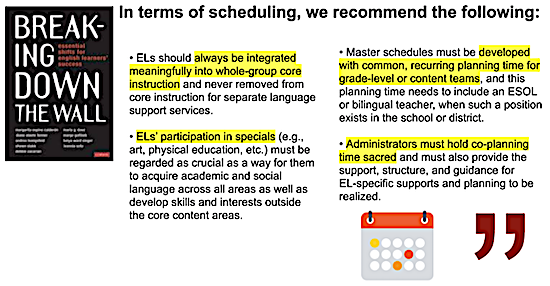
Teachers are not the only ones who principals can galvanize on behalf of language learners. Principals can also invite families and community partners to contribute to students’ learning experiences. Families have valuable life experiences that can bring conceptual knowledge to life.
They can offer cultural expertise and serve as primary sources for research, technical and professional expertise. Technology such as Talking Points (a free text messaging program that translates SMS messages into 100+ languages for users in the US and Canada) can remove some of the language barrier.
Community partners can offer hands-on learning experiences to apply content knowledge and develop particular skills, such as
• job shadows
• internships
• field trips
• guest speakers
• demonstrations
Begin to reach out to families and community partners so that they can support our efforts in educating your youngest citizens.
3. PROTECT
► Protect students’ right to accessing challenging grade-level expectations.
► Protect students’ right to use their home languages in schools.
Simply having language learners integrated into a general education class does not mean we are holding them to the same high expectations as their English-proficient peers.
During staff meetings, principals can showcase how a particular content teacher has maintained high expectations of ELs or share the work of a language learner who has produced exceptional work to meet grade-level expectations.
There are expectations that stretch students and expectations that snap their spirits. To help students stretch their skills to meet grade-level expectations, principals can protect language learners’ rights to use their home languages in school.
Allowing home languages in the classroom provides students with a means to access the same rigorous content as their peers but in a way they can understand it (e.g., translated texts, translated subtitles on videos, texts produced originally in the home language) (Yzquierdo, 2017).
Principals become superheroes in the eyes of language learners when they hold an open-language policy; they are relieved that they have another tool to use that isn’t only allowed, it’s encouraged. Open-language policies encourage schools to honor, develop, and use all languages as processing and communication tools.
4. PLANT
► Cultivate a culture where the faculty focus on what language learners can do, not what they cannot.
► Nurture a culture where everyone is a teacher of language, not just the EL teacher.
The foundation of inclusive education depends on how teachers see language learners. The role of the principal is to set a culture where teachers see language learners and their families through a lens of what language learners can do (asset-based) and not what they cannot (deficit-based). Principals can establish that culture by being hyper-conscious of the language they use to describe language learners, their experiences, and their families.
Words/phrases to use are:
• Beginners instead of “low” or “limited”
• Can do with help instead of “can’t”
• Our students instead of “Mrs. Barber’s kids”
Expounding on the last bullet, principals can establish a culture where everyone is a teacher of language. This does not mean that a science teacher has to teach what a gerund is. It does mean that a science teacher has to teach how to write a lab report and how to communicate the results of an experiment.
Teaching language means teaching the language of your discipline or content area (Cummins & Early, 2015; Ottow, 2019). It means teaching how musicians talk about art, how physical trainers describe a body part, and how woodshop teachers talk about the design cycle to plan a project.
In short, being a teacher of language means teaching the vocabulary, the sentence structure, and the organization of ideas needed to be successful in that discipline.
Culture doesn’t happen accidentally. Culture is the plot of land we cultivate with each interaction and where we promote growth by our words, actions, systems, and policies.
Principals, you are the key creators of school culture through your words, actions, systems, and policies. The work teachers do with language learners cannot be done without your support. I hope that these principles serve you in your work in your schools and with your faculty and students!
References
Cummins, J., & Early, M. (2015). Big ideas for expanding minds: Teaching English language learners across the curriculum. Don Mills, Ontario: Pearson Canada Inc.
Darling-Hammond, L., Wei, R., Andree, A., Richardson, N., & Orphanos, S. (2009). Professional learning in the learning profession: A status report on teacher development in the United States and abroad. Oxford, OH: National Staff Development Council.
Echevarria,J., Vogt, M.E., & Short, D. (2017). Making content comprehensible for English learners: The SIOP Model. Boston: Pearson.
Education Commission of the States (2014, November). What ELL training, if any, is required of general classroom teachers? Retrieved from http://ecs.force.com/mbdata/mbquestNB2?rep=ELL1415.
Honigsfeld, A., & Dove, M.G. (2019). Collaborating for English Learners: A Foundational Guide to Integrated Practices. Thousand Oaks, CA: Corwin.
Kunc, N., & Van der Klift, E. (2018). Earcos Teacher’s Conference. EARCOS Teacher’s Conference. Bangkok.
Ottow, S. B. (2019). The language lens for content classrooms: A guide for K-12 teachers of English and academic language learners. West Palm Beach, FL: Learning Sciences International.
Yzquierdo, M. L. (2017). Pathways to Greatness for Ell Newcomers. Irving, TX: Seidlitz Education.
Wixom, M. A. (2014, November 1). 50-State Comparison: English Language Learners. Retrieved July 12, 2019, from https://www.ecs.org/english-language-learners/

